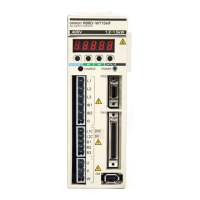Chapter 3
3-39
System Design and Installation
Note There is some loss due to winding resistance, so the actual regenerative energy will be approx-
imately 90% of the values derived from these equations.
• For Servo Driver models with internal capacitors for absorbing regenerative energy (i.e., models of
400 W or less.), the values for both E
g1
or [E
g2
+E
g3
] (unit: J) must be lower than the Servo Driver’s
regenerative energy absorption capacity. (For details, refer to 3-3-2 Servo Driver Regenerative
Energy Absorption Capacity.)
• For Servo Driver models with internal regeneration resistance for absorbing regenerative energy
(i.e., models of 750 W), the average amount of regeneration P
r
(unit: W) must be calculated, and
this value must be lower than the Servo Driver’s regenerative energy absorption capacity. (For
details, refer to 3-3-2 Servo Driver Regenerative Energy Absorption Capacity.)
The average amount of regeneration (P
r
) is the power consumed by regeneration resistance in
one cycle of operation.
P
r
= (E
g1
+ E
g2
+ E
g3
)/T [W]
T: Operation cycle [s]
3-3-2 Servo Driver Regenerative Energy Absorption Capacity
■ Amount of Internal Regeneration Resistance in Servo Drivers
SMARTSTEP A-series Servo Drivers absorb regenerative energy by means of internal capacitors or
resistors. If the regenerative energy is more than can be processed internally, an overvoltage error is
generated and operation cannot continue. The following table shows the regenerative energy (and
amount of regeneration) that the individual Servo Drivers themselves can absorb. If these values are
exceeded, take the following measures.
• Connect external regeneration resistance (to improve the regeneration processing capacity).
• Reduce the operating rotation speed. (The amount of regeneration is proportional to the square of
the rotation speed.)
• Lengthen the deceleration time (to decrease the regenerative energy produced per time unit).
• Lengthen the operation cycle, i.e., the cycle time (to decrease the average regenerative power).
N1, N2: Rotation speed at beginning of deceleration [r/min]
T
D1, TD2: Deceleration torque [N·m]
T
L2: Torque when falling [N·m]
t
1, t3: Deceleration time [s]
t
2: Constant-velocity travel time when falling [s]
• Eg1 = • • N1 • TD1 • t1 [J] = 0.0524 • N1 • TD1 • t1 [J]
260
60
2π
2π
1
• E
g2 = • N2 • TL2 • t2 [J] = 0.105 • N2 • TL2 • t2 [J]
60
2π
• E
g3 = • • N2 • TD2 • t3 [J] = 0.0524 • N2 • TD2 • t3 [J]
2
1

